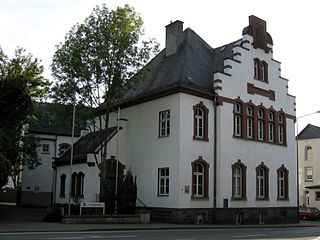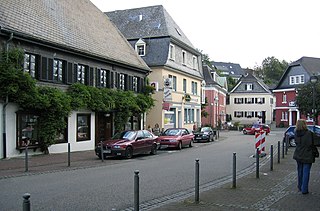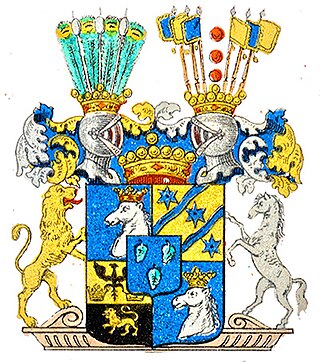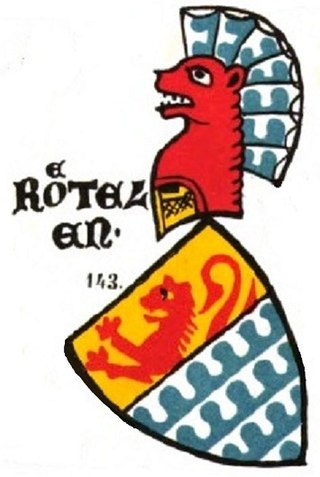The House of Ascania was a dynasty of German rulers. It is also known as the House of Anhalt, which refers to its longest-held possession, Anhalt.

The County of Mark was a county and state of the Holy Roman Empire in the Lower Rhenish–Westphalian Circle. It lay south of Lippe river on both sides of the Ruhr river along the Volme and Lenne rivers.

Plettenberg is a town in the Märkischer Kreis, in North Rhine-Westphalia, Germany.

Meinerzhagen is a town in the Märkischer Kreis, North Rhine-Westphalia, Germany.

The Prince-Bishopric of Würzburg was an ecclesiastical principality of the Holy Roman Empire located in Lower Franconia, west of the Prince-Bishopric of Bamberg. Würzburg had been a diocese since 743. As established by the Concordat of 1448, bishops in Germany were chosen by the canons of the cathedral chapter and their election was later confirmed by the pope. Following a common practice in Germany, the prince-bishops of Würzburg were frequently elected to other ecclesiastical principalities as well. The last few prince-bishops resided at the Würzburg Residence, which is one of the grandest Baroque palaces in Europe.

Lennestadt lies in the Sauerland in southeast North Rhine-Westphalia and is a community in Olpe district. It is the district's most populous municipality. Lennestadt itself is not an actual town but a community which comprises several towns and villages.

Kirchhundem is a German community in North Rhine-Westphalia. It belongs to the Olpe district.

The House of Schwarzenberg is a German (Franconian) and Czech (Bohemian) aristocratic family, formerly one of the most prominent European noble houses. The Schwarzenbergs are members of the German and Czech nobility, and they once held the rank of Princes of the Holy Roman Empire. The family belongs to the high nobility and traces its roots to the Lords of Seinsheim during the Middle Ages.

The Counts of Gorizia, also known as the Meinhardiner, House of Meinhardin, were a comital, princely and ducal dynasty in the Holy Roman Empire. Named after Gorizia Castle in Gorizia, they were originally "advocates" (Vogts) in the Patriarchate of Aquileia who ruled the County of Gorizia (Görz) from the early 12th century until the year 1500. Staunch supporters of the Emperors against the papacy, they reached the height of their power in the aftermath of the battle of Marchfeld between the 1280s and 1310s, when they controlled most of contemporary Slovenia, western and south-western Austria and part of northeast Italy mostly as (princely) Counts of Gorizia and Tyrol, Landgraves of Savinja and Dukes of Carinthia and Carniola. After 1335, they began a steady decline until their territories shrunk back to the original County of Gorizia by the mid 1370s. Their remaining lands were inherited by the Habsburg ruler Maximilian I.

The House of Limburg-Stirum, which adopted its name in the 12th century from the immediate county of Limburg an der Lenne in what is now Germany, is one of the oldest families in Europe. It is the eldest and only surviving branch of the House of Berg, which was among the most powerful dynasties in the region of the lower Rhine during the Middle Ages. Some historians link them to an even older dynasty, the Ezzonen, going back to the 9th century.

The County of Dassel emerged shortly after the turn of the 11th and 12th centuries when, after the extinction of the male line of the Billungs, its seat in Suilbergau, north of the Solling hills was divided into the domains of Einbeck and Dassel. Reinold of Dassel was able to secure rights similar to comital rights. The county lasted about 200 years, till it was abandoned in 1310 when there were no heirs. The most prominent member of the comital family was Rainald of Dassel, chancellor to Emperor Frederick Barbarossa and Archbishop of Cologne.

The Tanche family or Tank is the name of one or more Dano-Norwegian noble families of German origin. One of those lines is from Haderslev.

The House of Merveldt is the name of an ancient Westphalian aristocratic family, which belongs to the German nobility of the Middle Ages. The Herrn (Lords) von Merveldt were among the oldest families in the Münsterland. Merfeld, the eponymous seat of the family, is now a neighborhood of the city of Dülmen in the District of Coesfeld in the state of North Rhine-Westphalia in Germany.

The Manndorff zu Pfannhofen und Wissenau family is an ancient Austrian noble family, more specifically the Uradel. They are among the oldest Carinthian noble families still in existence today.

Bilstein Castle is a hill castle in the Sauerland in Germany. It is located in the eponymous quarter of Bilstein in the town of Lennestadt. Since 1927 the building has been a youth hostel.
Amt Bilstein was an administrative district in what is now the region of Westphalia, Germany. Its territory corresponded more or less with the current municipality of Lennestadt. It was first mentioned in 1434 and, until 1803, was part of the Duchy of Westphalia and thus the Electorate of Cologne, before it was transferred to the Landgraviate of Hesse-Darmstadt, from which, in 1806 the Grand Duchy of Hesse emerged. Following a ruling by the Congress of Vienna this association came to an end and, on 1 August 1816, the territory of the Amt became part of the newly formed Regierungsbezirk Arnsberg in the Prussian Province of Westphalia. It became a subdivision of the Kreis Olpe. The Amt was disbanded in 1969.
The Barony of Bilstein was a dynastic lordship with extensive estates in the region of the present German states of Hesse and Thuringia and a territory of the Holy Roman Empire.

The House of Egloffstein is an ancient Franconian aristocratic family (Uradel) with an eponymous family home in the hill region of Franconian Switzerland in the Bavarian province of Upper Franconia. The family first appears in the records in 1187 with a Heinrich genannt Stuchs who is also the progenitor. The house belongs to the brotherhood of Franconian Imperial Knights. Egloffstein Castle and Kunreuth Castle are to this day owned by the family.

The Koskullfamily, also written as Koschkull, is a wealthy aristocratic family of Livonian and German origin, famous for their extensive lands and manors. The family is descended from the first King of Livonia and officially established in Livonia as Koskele in 1302. The family spread to Estonia, Courland and Poland in the 15th century, Sweden and Finland in the 17th century, and Prussia and Russia in the 18th century. Several branches of the family still exist today. The Koskulls are believed to be related to the von der Pahlen family.

The House of Rötteln was a noble family based in the Basel area that can be documented between 1102/3 and 1316. The family, whose castle was located near Lörrach, had large estates in southern Breisgau, particularly in the Wiesental, where a member of the family elevated Schopfheim to the status of a town. Around the middle of the 13th century, the family was at the height of its power, the Röttlers Walther and Lüthold I became bishops of Basel, Lüthold II was about to become provost of the cathedral and bishop elect. With him, the family died out in the male line in 1316 and was inherited by the Margraves of Hachberg-Sausenberg. The Röttler inheritance was an important step in forming the later Markgräflerland.


















